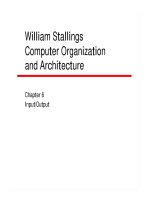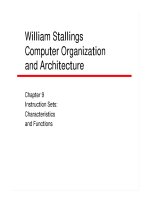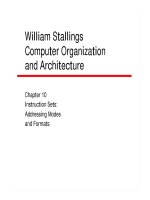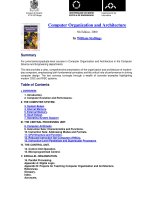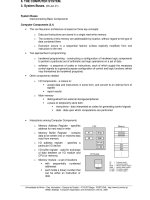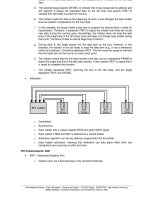Bài giảng Computer Organization and Architecture: Chapter 4
Bạn đang xem bản rút gọn của tài liệu. Xem và tải ngay bản đầy đủ của tài liệu tại đây (489.43 KB, 53 trang )
William Stallings
Computer Organization
and Architecture
6th Edition
Chapter 4
Cache Memory
Characteristics
•
•
•
•
•
•
•
•
Location
Capacity
Unit of transfer
Access method
Performance
Physical type
Physical characteristics
Organisation
Location
• CPU
• Internal
• External
Capacity
• Word size
—The natural unit of organization
• Number of words
—or Bytes
Unit of Transfer
• Internal
—Usually governed by data bus width
• External
—Usually a block which is much larger than a word
• Addressable unit
—Smallest location which can be uniquely addressed
—Word internally
—Cluster on M$ disks
Access Methods (1)
• Sequential
— Start at the beginning and read through in order
— Access time depends on location of data and previous location
— e.g. tape
• Direct
— Individual blocks have unique address
— Access is by jumping to vicinity plus sequential search
— Access time depends on location and previous location
— e.g. disk
Access Methods (2)
• Random
— Individual addresses identify locations exactly
— Access time is independent of location or previous access
— e.g. RAM
• Associative
— Data is located by a comparison with contents of a portion of the
store
— Access time is independent of location or previous access
— e.g. cache
Memory Hierarchy
• Registers
—In CPU
• Internal or Main memory
—May include one or more levels of cache
—“RAM”
• External memory
—Backing store
Memory Hierarchy - Diagram
Performance
• Access time
—Time between presenting the address and getting the
valid data
• Memory Cycle time
—Time may be required for the memory to “recover”
before next access
—Cycle time is access + recovery
• Transfer Rate
—Rate at which data can be moved
Physical Types
• Semiconductor
—RAM
• Magnetic
—Disk & Tape
• Optical
—CD & DVD
• Others
—Bubble
—Hologram
Physical Characteristics
•
•
•
•
Decay
Volatility
Erasable
Power consumption
Organisation
• Physical arrangement of bits into words
• Not always obvious
• e.g. interleaved
The Bottom Line
• How much?
—Capacity
• How fast?
—Time is money
• How expensive?
Hierarchy List
•
•
•
•
•
•
•
•
Registers
L1 Cache
L2 Cache
Main memory
Disk cache
Disk
Optical
Tape
So you want fast?
• It is possible to build a computer which uses
only static RAM (see later)
• This would be very fast
• This would need no cache
—How can you cache cache?
• This would cost a very large amount
Locality of Reference
• During the course of the execution of a program,
memory references tend to cluster
• e.g. loops
Cache
• Small amount of fast memory
• Sits between normal main memory and CPU
• May be located on CPU chip or module
Cache operation - overview
•
•
•
•
CPU requests contents of memory location
Check cache for this data
If present, get from cache (fast)
If not present, read required block from main
memory to cache
• Then deliver from cache to CPU
• Cache includes tags to identify which block of
main memory is in each cache slot
Cache Design
•
•
•
•
•
•
Size
Mapping Function
Replacement Algorithm
Write Policy
Block Size
Number of Caches
Size does matter
• Cost
—More cache is expensive
• Speed
—More cache is faster (up to a point)
—Checking cache for data takes time
Typical Cache Organization
Mapping Function
• Cache of 64kByte
• Cache block of 4 bytes
—i.e. cache is 16k (214) lines of 4 bytes
• 16MBytes main memory
• 24 bit address
—(224=16M)
Direct Mapping
• Each block of main memory maps to only one
cache line
—i.e. if a block is in cache, it must be in one specific
place
• Address is in two parts
• Least Significant w bits identify unique word
• Most Significant s bits specify one memory
block
• The MSBs are split into a cache line field r and a
tag of sr (most significant)
Direct Mapping
Address Structure
Tag sr
8
Line or Slot r
Word w
14
• 24 bit address
• 2 bit word identifier (4 byte block)
• 22 bit block identifier
— 8 bit tag (=2214)
— 14 bit slot or line
• No two blocks in the same line have the same Tag field
• Check contents of cache by finding line and checking Tag
2

